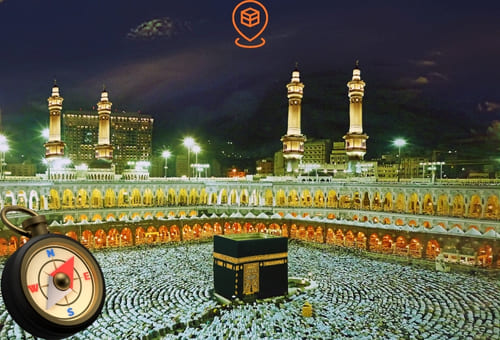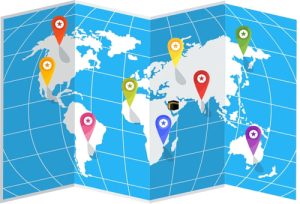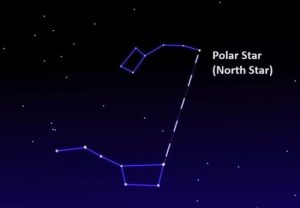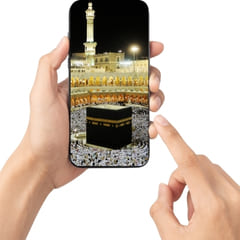
The Qiblah refers to the direction of the Ka’bah to which Muslims should turn for prayer, wherever they are. Prayer is only permissible and valid if it is performed facing the Qiblah. This includes all prayers, whether obligatory or supererogatory, as well as the funeral prayer and the prostration of tilawat. The Qiblah is the Ka’bah itself for those in Makkah and the direction of the Ka’bah for those outside Makkah. If the qibla is not known for certain, the person praying must do research to determine the direction of the qibla. After the necessary research, he should pray in the direction of the qibla he has determined. In this case, the prayer is valid even if the qibla direction is wrong.

How to find the direction of Qibla?

a) Finding the qibla direction with the sun



b) Finding direction and qibla with a compass
The first tool to be used for direction finding is usually a compass. If those who love nature sports, go on a trip or picnic keep such a compass with them, they will be very comfortable in determining the direction as well as determining the qibla. How will we find our direction with a compass? First of all, you should make sure that there is nothing metal around you. Hold the compass in your hand and parallel to the ground. Or place it on a table. Because the compass needle should be held in this way so that it can rotate comfortably. Wait until the compass needle is still. The colored tip of the compass needle points north. When you turn to the north side of the compass, your back side is south, your right side is east and your left side is west. Which side of Mecca is your location on? From here you can approximately determine your qibla direction. For example, in European countries, the qibla is generally to the southeast. (in the northern hemisphere)

c) Finding direction with the north star at night

Just draw a line between these two stars and extend it about 5 times towards the Little Dipper and you will eventually find Polaris. If you have any questions, take a look at the image we have provided for you. If you have trouble recognizing the Big Dipper and the Little Dipper in the night sky, it will help to know the following information about these two constellations. When one is upright, the other is upside down. This means that the handles of the coffee pots will always lie opposite each other. Also, even though the Great Coffee Pot will go around and around Polaris all day long, Dubhe and Merak will always point to Polaris. If you move North on Earth, Polaris will climb higher in the sky. When you reach the North Pole, Polaris appears directly overhead. When you go south, Polaris moves closer to the horizon. If you cross the equator from the northern hemisphere to the southern hemisphere, Polaris is below the horizon and cannot be seen. Now that we have found the pole star, you should know our direction: Once you have determined our north direction from the North Pole star, you can easily find the other directions based on what has already been described. (Source: uzay.co)
d) Finding Direction in Nature (Northern Hemisphere)
1) Ant Nests: Ants are warm and sun-loving animals. Therefore, they want to be exposed to more sunlight. Therefore, they build their nests in environments that can see the south side. In order to benefit more from the sun, they pile the mouth of their nests on the south side and the soil they remove on the north side so that it does not obstruct the sun. Or we can also say; ants keep the north-facing side of the soil they pile around their nests higher.
2) Wayfinding with mosses: Land mosses like moisture and do not like sunlight. Therefore, mosses/greening at the base or trunk of stones and trees point to the north. In the southern hemisphere, it is on the south side. This method can sometimes be inconclusive. For example, in some cases, in a humid environment, all or a significant part of the tree may be covered with moss.
3) Plants and Trees: Sunflower flowers in the northern hemisphere – at night – and cacti in the desert lean towards the south. Tree branches usually grow and elongate in a southerly direction. Especially when you look up from the bottom of large trees, you may notice that the branches are more dominated by the south side. If you see a freshly cut tree root in your neighborhood, look at the rings on it. The side with the shorter width of the rings is the north. The side with wider ring spacing is the south. The vegetation on the sun side of mountainous and hillside areas is richer. Therefore, plants on the south side of hillsides bloom and develop earlier.

5) Snow Melting: Snow on the south side of mountains melts more quickly. Snow on the slopes or on the north-facing side of mountains melts later.
e) Finding Qibla with a cell phone

1- You can find the qibla by downloading the qibla compass and similar applications from the Google Play Store or Apple App Store. But for this, your cell phone must have a compass sensor feature.
2- You can find the qibla direction with the online maps technique from the internet. You can get your qibla direction line from sites that use Google Maps infrastructure. For example; like qiblafinder.org.
3- Learn the qibla degree of your location for the compass. Then, while the location service of your cell phone is active, open the compass application. Now find the Qibla for your location by rotating the cell phone. And that’s it. For more details, please see our topic “Finding Qibla Direction with Cell Phone”.
Leave a Reply